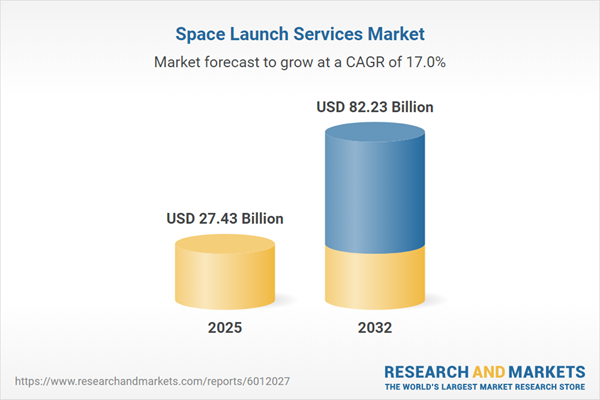Speak directly to the analyst to clarify any post sales queries you may have.
Senior executives navigating the global space launch services market face a landscape defined by rapid technological shifts, evolving regulation, and rising private sector participation. As new entrants disrupt legacy frameworks, mastering strategy and insight drives critical advantage for informed market leadership.
Market Snapshot: Space Launch Services Market Growth & Outlook
The Space Launch Services Market is expanding significantly, with growth from USD 23.48 billion in 2024 to USD 27.43 billion in 2025 and a projected CAGR of 16.96%, forecast to reach USD 82.23 billion by 2032. This robust escalation reflects heightened investment, emergent mission types, and global demand for advanced launch solutions. As companies leverage innovation to deliver scalable, responsive, and diversified services, decision-makers must keep pace with dynamic developments shaping competitiveness across the space value chain.
Scope & Segmentation
- Launch Vehicle Type: Expendable, Reusable
- Orbit: Geostationary Transfer, Low Earth, Medium Earth, Polar, Sun Synchronous
- Payload Type: Cargo (Commercial Logistics, Station Resupply), Crew (Astronaut Transport, Tourist Flights), Satellite (Commercial Communications, Earth Observation, Navigation)
- Propulsion Type: Chemical (Liquid Propellant, Solid Propellant), Electric, Hybrid
- Launch Mass: Heavy, Medium, Small
- End User: Commercial (Earth Observation, Telecommunications), Government/Military (Civil Government, Defense), Research (Academic, Space Science)
- Regions Analyzed: Americas (North America: United States, Canada, Mexico; Latin America: Brazil, Argentina, Chile, Colombia, Peru), Europe, Middle East & Africa (countries across Europe, Middle East, Africa), Asia-Pacific (China, India, Japan, Australia, South Korea, Indonesia, Thailand, Malaysia, Singapore, Taiwan)
- Companies Profiled: Space Exploration Technologies Corp., China Aerospace Science and Technology Corporation, Arianespace SA, United Launch Alliance, LLC, State Space Corporation Roscosmos, Rocket Lab USA, Inc., Northrop Grumman Innovation Systems, Inc., Mitsubishi Heavy Industries, Ltd., International Launch Services, LLC, ExPace Technology Co., Ltd.
Key Takeaways: Strategic Insights for Senior Decision-Makers
- Reusable vehicle innovation is shifting operational models and reducing entry barriers for new market participants, enabling faster mission turnaround and lower costs over time.
- Growing adoption of rideshare, modular payload, and rideshare aggregation services is enabling more frequent, flexible launch schedules for a broader range of customers and payload types.
- Digital technologies, including advanced analytics and digital twins, are enhancing launch reliability and mission assurance by optimizing ground operations and predictive maintenance.
- Sustainability priorities are increasingly central, with launch providers developing greener propellant options and end-of-life debris mitigation protocols to ensure responsible orbital access.
- Regional dynamics are fostering collaboration among countries and private entities, with local regulatory climates and infrastructure investments driving customized go-to-market strategies in every region.
Tariff Impact: Navigating Supply Chain & Sourcing Shifts
Imminent United States tariff measures targeting imports of key composite materials, semiconductors, and precision components will affect production costs and negotiation cycles industry-wide. Companies with vertically integrated or localized supply chains may better insulate themselves from cost fluctuations, while others must reconfigure sourcing strategies and forge new procurement partnerships. These shifts encourage joint ventures and government incentives to mitigate tariff pressures and maintain global competitiveness.
Methodology & Data Sources
This research draws from a combination of expert interviews, comprehensive secondary source analysis, and robust triangulation. Insights were shaped through direct engagement with industry thought leaders and corroborated by rigorous cross-referencing of technical, regulatory, and performance data. The approach ensures accuracy and high relevance for strategic planning.
The Space Launch Services Market: Why This Report Matters
- Enables leaders to benchmark evolving strategies, identify emerging mission opportunities, and understand disruptive technology trends directly impacting launch economics and operational agility.
- Equips organizations to optimize procurement and supply chain management in response to shifting regulations and competitive pressures across regions.
- Supports investment, partnership, and innovation planning with actionable segmentation and clear company profiles for top industry players.
Conclusion
This executive summary provides the clarity and context senior market participants need to navigate the complexities of today's space launch services industry. Informed strategic decisions rely on timely analysis and deep market insight.
Additional Product Information:
- Purchase of this report includes 1 year online access with quarterly updates.
- This report can be updated on request. Please contact our Customer Experience team using the Ask a Question widget on our website.
Table of Contents
3. Executive Summary
4. Market Overview
7. Cumulative Impact of Artificial Intelligence 2025
Companies Mentioned
The companies profiled in this Space Launch Services market report include:- Space Exploration Technologies Corp.
- China Aerospace Science and Technology Corporation
- Arianespace SA
- United Launch Alliance, LLC
- State Space Corporation Roscosmos
- Rocket Lab USA, Inc.
- Northrop Grumman Innovation Systems, Inc.
- Mitsubishi Heavy Industries, Ltd.
- International Launch Services, LLC
- ExPace Technology Co., Ltd.
Table Information
| Report Attribute | Details |
|---|---|
| No. of Pages | 187 |
| Published | October 2025 |
| Forecast Period | 2025 - 2032 |
| Estimated Market Value ( USD | $ 27.43 Billion |
| Forecasted Market Value ( USD | $ 82.23 Billion |
| Compound Annual Growth Rate | 16.9% |
| Regions Covered | Global |
| No. of Companies Mentioned | 11 |









